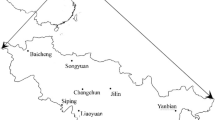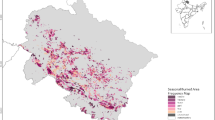Abstract
For efficient forest fire management, special precautions are required in dry and strong-wind seasons vulnerable to severe forest fires. To extract the seasonal characteristics of forest fires in South Korea, the statistics over the past 16 years, 1991 through 2005, were investigated. The daily records of the number of fire occurrences, the total area burned and the average burned area per occurrence were examined to identify the seasonal patterns of forest fires using cluster analysis and principal component analysis; the risk of daily fires was also assessed using the ordered logit model. As a result, the fire patterns were classified into five clusters and a general danger index for forest fires was derived from the first principal component, showing relatively large-scaled fire regimes in spring, and frequent small-scaled fire regimes in autumn and winter. In connection with the ordered logit model, the probability for the five ranks of forest fire risk was calculated and the threshold for high-risk fires was detected. As an implementation of the results above, the proper forest fire precautionary period in South Korea was estimated, and consequently October 21 through May 17 was recognized as a dry season at a high risk of forest fires. This period began 10 days earlier in autumn and extended into midwinter (late December and January) as opposed to the existing precautionary period, indicating the need of more cautious forest fire management earlier in autumn and continuing through midwinter.





Similar content being viewed by others
References
Andrew PL, Loftsgaarden DO, Bradshaw LS (2003) Evaluation of fire danger rating indexes using logistic regression and percentile analysis. Int J Wildland Fire 12:213–226
Beverly JL, Wotton BM (2007) Modelling the probability of sustained flaming: predictive value of fire weather index components compared with observations of site weather and fuel moisture conditions. Int J Wildland Fire 16:161–173
Bovio G, Camia A (1997) Land zoning based on fire history. Int J Wildland Fire 7:249–258
Cardille JA, Ventura SJ, Turner MG (2001) Environmental and social factors influencing wildfires in the Upper Midwest, United States. Ecol Appl 11:111–127
Cooke WF, Koffi B, Gregorie JM (1996) Seasonality of vegetation fires in Africa from remote sensing data and application to a global chemistry model. J Geophys Res 101:21051–21066
Crimmins MA, Comrie A (2004) Interactions between antecedent climate and wildfire variability across south-eastern Arizona. Int J Wildland Fire 13:455–466
Dwyer EJ, Pereira JMC, Gregoire JM, DaCamera CC (2000) Characterization of the spatio-temporal patterns of global fire activity using satellite imagery for the period April 1992 to March 1993. J Biogeogr 27:57–69
Gill AM (1975) Fire and the Australian flora: a review. Aust For 38:4–25
Gilless JK, Fried JS (1998) Stochastic representation of fire behavior in a wildland fire protection planning model for California. For Sci 45:492–499
Groisman PU, Sherstyukov BG, Razuvaev VN, Knight RW, Enloe JG, Stroumentova NS, Whitfield PH, Forland E, Hannsenbauer I, Tuomenvirta H, Aleksandersson H, Mescherskaya AV, Kari TR (2007) Potential forest fire danger over Northern Eurasia: changes during the 20th century. Glob Planet Change 56:371–386
Hardy CC, Schmidt KM, Menakis JP, Sampson NR (2001) Spatial data for national fire planning and fuel management. Int J Wildland Fire 10:353–372
Ji Y, Stocker E (2002) Seasonal, intraseasonal, and interannual variability of global land fires and their effects on atmospheric aerosol distribution. J Geophys Res 107:4697
Keane RE, Cary GJ, Parsons R (2003) Using simulation to map fire regimes: an evaluation of approaches, strategies, and limitations. Int J Wildland Fire 12:309–322
Korea Forest Information Management System (2006) http://152.99.197.40/sanfire/main/index.asp
Korea Forest Service (2004) Annual reports on statistical analysis of forest fires in Korea. Korea Forest Service, Daejeon
Korea Meteorological Administration (2004) Annual climatological report. Korean Meteorological Administration, Seoul
Kwon WT (2005) Current status and perspectives of climate change sciences. J Korean Meteorol Soc 41:325–336
Lee BD (2005) Analysis of behavior characteristics of the 2000 Samcheok forest fire using GIS/RS and development of a forest fire growth prediction model. D. Agr. thesis, Seoul National University, Korea
Lee BD, Chung JS (2006) Estimation of time series model on forest fire occurrences and burned area from 1970 to 2005. J Korean For Soc 95:643–648
Lee BD, Park PS, Chung JS (2006) Temporal and spatial characteristics of forest fires in South Korea between 1970 and 2003. Int J Wildland Fire 15:389–396
Oh JH (2002) Climate change and society for the 21st century. Korean J Atmos Sci 5:121–129
Palumbo I, Gregoire JM, Boschetti L, Eva H (2003) Fire regimes in protected areas of sub-saharan Africa, derived from the GBA2000 dataset. In: Chuvieco E, Martin PI, Justice C (eds) Innovative concepts and methods in fire danger estimation, 4th workshop on remote sensing and GIS applications to forest fire management. EARSEL, Ghent, pp 139–149
Parisien MA, Peters VS, Wang Y, Little JM, Bosch EM, Stocks BJ (2006) Spatial patterns of forest fires in Canada, 1980–1999. Int J Wildland Fire 15:361–374
Preisler HK, Westerling AL (2007) Statistical model for forecasting monthly large wildfire events in western United States. J Appl Meteorol Clim 46:1020–1030
Seong WH (2001) Applied logistic regression analysis: theory, methods, SAS applications. Tamjin Press, Seoul
Song MS, Cho SS (2004) Statistical data analysis using SAS program. Freedom Academy Press, Seoul
Spessa A, Harrison SP, Prentice IC, Cramer W, Mahowald N (2003) Confronting a burning question: the role of fire on Earth. Eos Trans Am Geophys Union 84:23–25
Steele TW, Stier JC (1998) An economic evaluation of public and organized wildfire detection in Wisconsin. Int J Wildland Fire 8:205–215
Stratton RD (2006) Guidance on spatial wildland fire analysis: models, tools, and techniques. Gen. Tech. Rep. RMRS-GTR-183. U.S. Department of Agriculture, Forest Service, Rocky Mountain Research Station, Fort Collins, CO
Sturtevant BR, Cleland DT (2007) Human and biophysical factors influencing modern fire disturbance in northern Wisconsin. Int J Wildland Fire 16:398–413
Tymstra C, Flannigan MD, Armitage OB, Logan K (2007) Impact of climate change on area burned in Alberta’s boreal forest. Int J Wildland Fire 16:153–160
Wotton BM, Flannigan MD (1993) Length of the fire season in a changing climate. For Chron 69:187–192
Author information
Authors and Affiliations
Corresponding author
About this article
Cite this article
Seol, A., Lee, B. & Chung, J. Analysis of the seasonal characteristics of forest fires in South Korea using the multivariate analysis approach. J For Res 17, 45–50 (2012). https://doi.org/10.1007/s10310-011-0263-8
Received:
Accepted:
Published:
Issue Date:
DOI: https://doi.org/10.1007/s10310-011-0263-8




